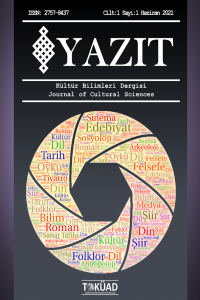Abstract
The novel Veba Geceleri, published in 2021 by Orhan Pamuk, which is about the plague epidemic and the process of nation-stateization in an imaginary Ottoman island (Minger Island), has a fiction that can be evaluated with its allegorical quality. The fiction can be read as a representation of the construction of an independent nation-state, which gained visibility in third world countries as well as the social and political conditions in today’s Turkey, based on certain points of view. However, the real attention in the fiction is not the allegorical quality in question, but in connection with this -more precisely with the allegorical possibility for the nation-state building in Turkey- that marked the recent history of Turkey, and which has come into existence with very strong symbolic values from historical personalities in various forms of thought it is the inclusion of two major political figures, which are sometimes considered in the axis of dual-opposition, to the character staff both together and in the foreground. One of these figures is Abdülhamit, the other is Atatürk, who is represented by Kolağası Kamil in the fiction. Here in our study; we will question how both figures gain visibility in the fiction, how the “imaginary narrator” Mîna Mingerli included them in the fiction with their positive and negative aspects. Then we will go to the background of the novel and examine the ideological basis of the formation of the two figures in fiction and their relationship with the current political attitude of the author.
Keywords
Orhan Pamuk Veba Geceleri Allegoric Fiction Political Figure Character Analysis. Orhan Pamuk, Veba Geceleri, Allegoric Fiction, Political Figure, Character Analysis
References
- Anderson, Benedict (2017). Hayali Cemaatler: Milliyetçiliğin Kökenleri ve Yayılması. Çev. İskender Savaşır. İstanbul: Metis Yayınları.
- Avcıoğlu, Doğan (1969). Türkiye'nin Düzeni: Dün-Bugün-Yarın. Ankara: Bilgi Yayınevi.
- Berkes, Niyazi (2007). Batıcılık, Ulusçuluk ve Toplumsal Devrimler. İstanbul: Kaynak Yayınları.
- Berkes, Niyazi (2012). Türkiye'de Çağdaşlaşma. Haz. Ahmet Kuyaş. İstanbul: Yapı Kredi Yayınları.
- Cengiz, Semran (2010). “Orhan Pamuk’un Romanlarında Doğu-Batı İkilemi”. Hacettepe Üniversitesi Türkiyat Araştırmaları Dergisi, 12: 63-88.
- Eagleton, Terry (2012). Kötülük Üzerine Bir Deneme. Çev. Şenol Bezci. İstanbul: İletişim Yayınları.
- Eco, Umberto (2013). Yorum ve Aşırı Yorum. Çev. Kemal Atakay. İstanbul: Can Yayınları.
- Jusdanis, Gregory (2015). Gecikmiş Modernlik ve Estetik Kültür: Milli Edebiyatın İcat Edilişi. Çev. Tuncay Birkan. İstanbul: Metis Yayınları.
- Karaosmanoğlu, Yakup Kadri (1981). Atatürk: Bir Tahlil Denemesi. Haz. Atilla Özkırımlı. İstanbul: Birikim Yayınları.
- Kısakürek, Necip Fazıl (2016). O ve Ben. İstanbul: Büyük Doğu Yayınları.
- Mumcu, Ahmet (1984). Tarih Açısından Türk Devriminin Temelleri ve Gelişimi. İstanbul: İnkılâp Yayınevi.
- Pamuk, Orhan (2021). Veba Geceleri. İstanbul: Yapı Kredi Yayınları.
- Said Halim Paşa (2020). Buhranlarımız ve Son Eserleri. Haz. M. Ertuğrul Düzdağ. İstanbul: İz Yayıncılık.
- Tevfik Fikret (2010). Rübâb-ı Şikeste-Târîh-i Kadîm-Rübâb’ın Cevâbı. Haz. Abdullah Uçman ve Hasan Akay. İstanbul: Çağrı Yayınları.
- Tokgöz, Ahmet İhsan (2020). Matbuat Hatıralarım. Haz. Necati Tonga. Ankara: Çolpan Kitap.
- Toprak, Zafer (2020). Atatürk: Kurucu Felsefenin Evrimi. İstanbul: Türkiye İş Bankası Kültür Yayınları.
- URL-1:”Orhan Pamuk Veba Gecelerini Anlattı, Minger Adası Tükiye’yi gösteren bir alegorinin çıkış noktası değildir” https://www.gazeteduvar.com.tr/orhan-pamuk-veba-gecelerini-anlatti-minger-adasi-turkiyeyi-gosteren-bir-alegorinin-cikis-noktasi-degildir-haber-1518449 (Erişim: 03.05.2021).
- URL-2:“Orhan Pamuk Atatürk ile dalga geçiyor”. https://odatv4.com/orhan-pamuk-ataturk-ile-dalga-geciyor-10042141.html (Erişim: 01.05.2021).
- URL-3:”Ümit Zileli - Nobel ödüllü yazarın iflah olmaz saplantısı” https://www.korkusuz.com.tr/nobel-odullu-yazarin-iflah-olmaz-saplantisi.html (Erişim: 01.05.2021).
- URL-4:”Ahmet Hakan – Orhan Pamuk romanında Atatürk’le alay mı ediyor?” https://www.hurriyet.com.tr/yazarlar/ahmet-hakan/orhan-pamuk-romaninda-ataturkle-alay-mi-ediyor-41785979 (Erişim: 01.05.2021).
- URL-5:”Pamuk: Ayasofya’nın müze olması laiklik mesajıydı” https://www.dw.com/tr/pamuk-ayasofyan%C4%B1n-m%C3%BCze-olmas%C4%B1-laiklik-mesaj%C4%B1yd%C4%B1/a-54302970(Erişim: 01.05.2021).
- URL-6:”Pamuk’a bir şeyler oldu: Muhalefet Büyük Atatürk’ün laiklik geleneğine sahip çıkmaktan korkuyor” https://www.birgun.net/haber/pamuk-a-bir-seyler-oldu-muhalefet-buyuk-ataturk-un-laiklik-gelenegine-sahip-cikmaktan-korkuyor-309485 (Erişim: 03.05.2021).
Abstract
References
- Anderson, Benedict (2017). Hayali Cemaatler: Milliyetçiliğin Kökenleri ve Yayılması. Çev. İskender Savaşır. İstanbul: Metis Yayınları.
- Avcıoğlu, Doğan (1969). Türkiye'nin Düzeni: Dün-Bugün-Yarın. Ankara: Bilgi Yayınevi.
- Berkes, Niyazi (2007). Batıcılık, Ulusçuluk ve Toplumsal Devrimler. İstanbul: Kaynak Yayınları.
- Berkes, Niyazi (2012). Türkiye'de Çağdaşlaşma. Haz. Ahmet Kuyaş. İstanbul: Yapı Kredi Yayınları.
- Cengiz, Semran (2010). “Orhan Pamuk’un Romanlarında Doğu-Batı İkilemi”. Hacettepe Üniversitesi Türkiyat Araştırmaları Dergisi, 12: 63-88.
- Eagleton, Terry (2012). Kötülük Üzerine Bir Deneme. Çev. Şenol Bezci. İstanbul: İletişim Yayınları.
- Eco, Umberto (2013). Yorum ve Aşırı Yorum. Çev. Kemal Atakay. İstanbul: Can Yayınları.
- Jusdanis, Gregory (2015). Gecikmiş Modernlik ve Estetik Kültür: Milli Edebiyatın İcat Edilişi. Çev. Tuncay Birkan. İstanbul: Metis Yayınları.
- Karaosmanoğlu, Yakup Kadri (1981). Atatürk: Bir Tahlil Denemesi. Haz. Atilla Özkırımlı. İstanbul: Birikim Yayınları.
- Kısakürek, Necip Fazıl (2016). O ve Ben. İstanbul: Büyük Doğu Yayınları.
- Mumcu, Ahmet (1984). Tarih Açısından Türk Devriminin Temelleri ve Gelişimi. İstanbul: İnkılâp Yayınevi.
- Pamuk, Orhan (2021). Veba Geceleri. İstanbul: Yapı Kredi Yayınları.
- Said Halim Paşa (2020). Buhranlarımız ve Son Eserleri. Haz. M. Ertuğrul Düzdağ. İstanbul: İz Yayıncılık.
- Tevfik Fikret (2010). Rübâb-ı Şikeste-Târîh-i Kadîm-Rübâb’ın Cevâbı. Haz. Abdullah Uçman ve Hasan Akay. İstanbul: Çağrı Yayınları.
- Tokgöz, Ahmet İhsan (2020). Matbuat Hatıralarım. Haz. Necati Tonga. Ankara: Çolpan Kitap.
- Toprak, Zafer (2020). Atatürk: Kurucu Felsefenin Evrimi. İstanbul: Türkiye İş Bankası Kültür Yayınları.
- URL-1:”Orhan Pamuk Veba Gecelerini Anlattı, Minger Adası Tükiye’yi gösteren bir alegorinin çıkış noktası değildir” https://www.gazeteduvar.com.tr/orhan-pamuk-veba-gecelerini-anlatti-minger-adasi-turkiyeyi-gosteren-bir-alegorinin-cikis-noktasi-degildir-haber-1518449 (Erişim: 03.05.2021).
- URL-2:“Orhan Pamuk Atatürk ile dalga geçiyor”. https://odatv4.com/orhan-pamuk-ataturk-ile-dalga-geciyor-10042141.html (Erişim: 01.05.2021).
- URL-3:”Ümit Zileli - Nobel ödüllü yazarın iflah olmaz saplantısı” https://www.korkusuz.com.tr/nobel-odullu-yazarin-iflah-olmaz-saplantisi.html (Erişim: 01.05.2021).
- URL-4:”Ahmet Hakan – Orhan Pamuk romanında Atatürk’le alay mı ediyor?” https://www.hurriyet.com.tr/yazarlar/ahmet-hakan/orhan-pamuk-romaninda-ataturkle-alay-mi-ediyor-41785979 (Erişim: 01.05.2021).
- URL-5:”Pamuk: Ayasofya’nın müze olması laiklik mesajıydı” https://www.dw.com/tr/pamuk-ayasofyan%C4%B1n-m%C3%BCze-olmas%C4%B1-laiklik-mesaj%C4%B1yd%C4%B1/a-54302970(Erişim: 01.05.2021).
- URL-6:”Pamuk’a bir şeyler oldu: Muhalefet Büyük Atatürk’ün laiklik geleneğine sahip çıkmaktan korkuyor” https://www.birgun.net/haber/pamuk-a-bir-seyler-oldu-muhalefet-buyuk-ataturk-un-laiklik-gelenegine-sahip-cikmaktan-korkuyor-309485 (Erişim: 03.05.2021).
Details
| Primary Language | Turkish |
|---|---|
| Subjects | Literary Studies, Literary Theory, Creative Arts and Writing |
| Journal Section | Research Articles |
| Authors | |
| Publication Date | June 4, 2021 |
| Published in Issue | Year 2021 Volume: 1 Issue: 1 |


